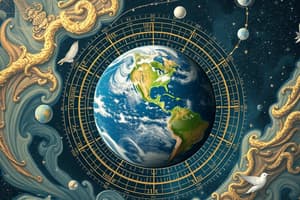Podcast
Questions and Answers
What is the approximate tilt of Earth's axis that contributes to seasonal changes?
What is the approximate tilt of Earth's axis that contributes to seasonal changes?
- 23.5 degrees (correct)
- 45 degrees
- 30 degrees
- 15 degrees
How long does it take for Earth to complete one revolution around the Sun?
How long does it take for Earth to complete one revolution around the Sun?
- 366 days
- 365 days
- 365.25 days (correct)
- 360 days
What phenomenon occurs when the Northern Hemisphere is tilted towards the Sun?
What phenomenon occurs when the Northern Hemisphere is tilted towards the Sun?
- Summer (correct)
- Winter
- Spring
- Autumn
What phase of the Moon occurs when the Moon is between Earth and the Sun?
What phase of the Moon occurs when the Moon is between Earth and the Sun?
What causes variations in the length of day throughout the year?
What causes variations in the length of day throughout the year?
During which event are daylight and nighttime approximately equal?
During which event are daylight and nighttime approximately equal?
What is the main effect of Earth's axial tilt on the seasons?
What is the main effect of Earth's axial tilt on the seasons?
Which phrase best describes the length of a complete rotation of Earth?
Which phrase best describes the length of a complete rotation of Earth?
What remains constant due to conservation principles during Earth's formation?
What remains constant due to conservation principles during Earth's formation?
What is the longest day of the year in the Northern Hemisphere known as?
What is the longest day of the year in the Northern Hemisphere known as?
Flashcards are hidden until you start studying
Study Notes
Rotation of the Earth
Causes of Rotation
- Initial Formation: Earth formed from the solar nebula, with angular momentum preserved from its original spinning cloud of gas and dust.
- Conservation of Angular Momentum: As Earth coalesced, its rotation speed increased due to conservation principles.
- Tilted Axis: Earth's axis is tilted at approximately 23.5 degrees, which affects various phenomena like seasons.
Revolution of the Earth
Effects of Revolution
- Year Length: One complete revolution around the Sun takes about 365.25 days, defining a year.
- Distance from the Sun: Varies throughout the year, impacting solar energy received on Earth.
- Ecliptic Plane: Earth's orbit occurs in a plane known as the ecliptic, which affects the visibility of constellations.
Seasons Change
- Tilted Axis: The axial tilt causes varying angles of sunlight at different times of the year, leading to seasons.
- Summer/Winter: When the Northern Hemisphere tilts toward the Sun, it experiences summer; conversely, the Southern Hemisphere experiences winter.
- Equinoxes: Daylight and nighttime are approximately equal during spring and fall equinoxes.
- Solstices: Longest day occurs at the summer solstice; shortest day at the winter solstice.
Length of Day
- 24-Hour Cycle: Earth’s rotation creates a day-night cycle, with one complete rotation taking about 24 hours.
- Variation: Length of day varies slightly throughout the year due to axial tilt and elliptical orbit, but averages around 24 hours.
- Daylight Saving Time: Introduced in various regions to make better use of daylight during longer days in summer.
Phases of the Moon
- New Moon: Moon is between Earth and Sun; not visible.
- Waxing Crescent: Small crescent of light appears as the moon moves away from the Sun.
- First Quarter: Half of the moon is illuminated; occurs when the moon is one-quarter of the way through its orbit.
- Waxing Gibbous: More than half of the moon is illuminated as it approaches full moon.
- Full Moon: Entirely illuminated; occurs when Earth is between the Sun and the Moon.
- Waning Phases: Following full moon, the illumination decreases through waning gibbous, last quarter, and waning crescent.
- Cycle Duration: Complete lunar cycle takes about 29.5 days.
Rotation of the Earth
- Earth formed from a solar nebula, preserving the angular momentum of the original spinning cloud of gas and dust.
- As Earth coalesced, its rotation speed increased due to the conservation of angular momentum.
- The axial tilt of approximately 23.5 degrees influences various climatic and seasonal phenomena.
Revolution of the Earth
- Earth completes one revolution around the Sun in about 365.25 days, which defines the length of a year.
- The distance from the Sun varies throughout the year, affecting the amount of solar energy received.
- Earth's orbit occurs on a plane known as the ecliptic, which influences the visibility patterns of constellations.
Seasons Change
- The axial tilt results in varying angles of sunlight throughout the year, creating distinct seasons.
- During summer in the Northern Hemisphere, it is tilted towards the Sun, while the Southern Hemisphere experiences winter.
- Spring and fall equinoxes result in nearly equal daylight and nighttime durations.
- The longest day of the year occurs at the summer solstice, while the shortest day occurs at the winter solstice.
Length of Day
- Earth's rotation creates a day-night cycle, completing one rotation in about 24 hours.
- The length of day varies slightly due to axial tilt and the elliptical shape of Earth's orbit, averaging around 24 hours.
- Daylight Saving Time is implemented in various regions to optimize the use of daylight during longer summer days.
Phases of the Moon
- A new moon occurs when the moon is positioned between Earth and the Sun and is not visible from Earth.
- The waxing crescent phase shows a small crescent of light as the moon moves away from the Sun.
- The first quarter phase features half of the moon illuminated, occurring when it is a quarter of the way through its orbit.
- The waxing gibbous phase displays more than half of the moon illuminated as it approaches the full moon.
- A full moon occurs when Earth is directly between the Sun and the Moon, making the entire surface of the moon visible.
- Following the full moon, the moon enters waning phases, decreasing in illumination through waning gibbous, last quarter, and waning crescent.
- A complete lunar cycle lasts approximately 29.5 days.
Studying That Suits You
Use AI to generate personalized quizzes and flashcards to suit your learning preferences.




